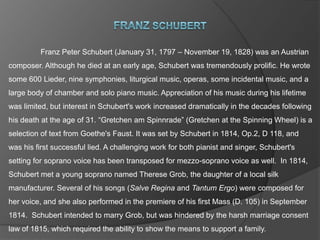
Listening guide 3
- 1. Franz Schubert Franz Peter Schubert (January 31, 1797 – November 19, 1828) was an Austrian composer. Although he died at an early age, Schubert was tremendously prolific. He wrote some 600 Lieder, nine symphonies, liturgical music, operas, some incidental music, and a large body of chamber and solo piano music. Appreciation of his music during his lifetime was limited, but interest in Schubert's work increased dramatically in the decades following his death at the age of 31. “Gretchen am Spinnrade” (Gretchen at the Spinning Wheel) is a selection of text from Goethe's Faust. It was set by Schubert in 1814, Op.2, D 118, and was his first successful lied. A challenging work for both pianist and singer, Schubert's setting for soprano voice has been transposed for mezzo-soprano voice as well. In 1814, Schubert met a young soprano named Therese Grob, the daughter of a local silk manufacturer. Several of his songs (Salve Regina and Tantum Ergo) were composed for her voice, and she also performed in the premiere of his first Mass (D. 105) in September 1814. Schubert intended to marry Grob, but was hindered by the harsh marriage consent law of 1815, which required the ability to show the means to support a family.
- 2. Gretchen am Spinnrade Gretchen is singing at her spinning wheel while thinking of Faust and all that he promises. The accompaniment mimics the spinning-wheel in constantly revolving semiquaver figurations in the right hand, the foot treadle back and forth in the left — speeding up and slowing down in response to the text, to show Gretchen's excitement or distraction. At the climax of the piece, the piano stops as Gretchen becomes overly distracted by the thought of Faust's kiss, and then only hesitatingly begins again as she realizes she has forgotten to keep spinning. Schubert ingeniously uses the piano to imitate the rhythmic repetition of the spinning wheel, perhaps mirroring either the hypnotic effect of temptation and the devil and/or love. The constancy of Gretchen's infatuation is alluded to not only by constancy of the spinning, but also by the repetition of the first stanza periodically throughout the song. Gretchen's beginning words (in German) are: Loosely translated to English, this means: MeineRuhisthin My peace of mind has fled Mein Herzistschwer My heart is heavy Ichfinde, ichfindesienimmer I will never find peace, und nimmermehr never again...
- 3. The accompaniment mimics the spinning-wheel in constantly revolving semiquaver figurations in the right hand, the foot treadle back and forth in the left. The form of this piece is in ABACADA, commonly referred to as a 7-part Rondo. Although the last A section is much more like a coda than an actual A section, but it is close enough. All of the A sections start out the same as the first, which we see in measure 2.
- 4. In measure 13 we get the B section with the text: Wo ich ihn nicht hab, Where I do not have him,Ist mir das Grab, That is the grave,Die ganze Welt The whole worldIst mir vergällt. Is bitter to me. Mein armer Kopf My poor headIst mir verrückt, Is crazy to me,Mein aremer Sinn My poor mindIst mir zerstückt. Is torn apart.
- 5. In measure 31 the A section returns just as it was before and in measure 42 the C section appears with the text: Nach ihm nur schau ich For him only, I lookZum Fenster hinaus, Out the windowNach ihm nur geh ich Only for him do I goAus dem Haus. Out of the house. Sein hoher Gang, His tall walk,Sein' edle Gestalt, His noble figure,Seines Mundes Lächeln, His mouth's smile,Seiner Augen Gewalt, His eyes' power, Und seiner Rede And his mouth'sZauberfluss, Magic flow,Sein Händedruck, His handclasp,Und ach, sein Kuss. and ah! his kiss!
- 6. In measure 73 the A section returns exactly as it was the first two times, and I will add that in this song it comes off like a modern refrain would. The D section arrives shortly after in measure 84 with the text: Mein Busen drängt My bosom urges itselfSich nach ihm hin. toward him.Auch dürf ich fassen Ah, might I graspUnd halten ihn, And hold him! Und küssen ihn, And kiss him,So wie ich wollt, As I would wish,An seinen Küssen At his kissesVergehen sollt! I should die!
- 7. As I mentioned before, the A section does return one last time but not in its entirety with only this text: Meine Ruh ist hin, My peace is gone,Mein Herz ist schwer. My heart is heavy. Because of this being in d minor and only part of the A section being at the end, it makes me wonder if the Faust she’s singing of is even still alive or just gone away from her. I guess it is left up to the listener. References: naxos.com, imslp.org, oxfordmusiconline.com, classicalmusic.about.com*, and wikipedia.org *All translations have been borrowed from classicalmusic.about.com